Peace lilies, also known as Spathiphyllum, are a favorite indoor blooming plant because of their beautiful white spathe flowers. This plant has large glossy green leaves and long flowering stems that make it a popular choice for indoor gardening. Peace lilies thrive in low light and shade, making them ideal for any room in your home.
Apart from its beauty, peace lilies are also known for their ability to purify indoor air by removing toxins. Although Spathiphyllum contains toxic chemicals, they are generally safe to handle. However, it is best to keep peace lilies out of reach of children and pets who might chew on the leaves.
To care for peace lilies, it is essential to provide them with bright filtered light, well-draining fertile soil, and average room temperatures. Water the plant when the soil is partially dry, and mist the leaves regularly to maintain humidity. During the growing season, fertilize every month. Peace lilies belong to the Araceae family, which includes 40 species of Spathiphyllum, and are closely related to the calla lily.
Despite being called a lily, Spathiphyllum is not a genuine species of the Lilium family. The plant’s botanical name was derived from its exquisite white spathe-leaves. Other common names for peace lilies include closet plants, white sails, and peace lily. The white spathe-leaf, which resembles a white sail or flag, is the subject of both last common names.
Peace lilies have different names such as Mouna Loa, Madonna lily, and Cupido peace lily. This article provides a complete guide for taking care of peace lilies. These blooming plants, which brighten up rooms and help clean the air, are easy to grow indoors.
Spathiphyllum Flowers

The Spathiphyllum flower is composed of two parts, the elongated spike called the spadix and a modified leaf known as the bract or spathe. The spathe is a large leaf-like structure that can be white or yellowish and surrounds the spadix, which is a thick stem covered in small flowers that produces the actual blooms.
Spathiphyllum flowering stalks can range from 4 to 12 inches (10 cm) in length, and most species have dazzling white spathes. However, in some types of Spathiphyllum, yellowish or greenish spathe leaves surround an orange spadix. These white sheath-type blooms provide a stunning contrast against the glossy green broad leaves of the plant.
Why My Spathiphyllum Isn’t Flowering?
The primary reason why Spathiphyllum may fail to bloom is due to inadequate exposure to bright light. To produce its beautiful blossoms, Spathiphyllum needs to be placed in a location with bright and indirect sunlight, and typically blooms during the spring season. Although Spathiphyllum can survive in low-light areas, it will not produce flowers if it lacks sufficient light exposure or is constantly placed in the shade.
How to Make a Spathiphyllum Plant Bloom?
Encouraging a Spathiphyllum to bloom can be achieved by providing it with sufficient indirect light and proper watering. If the plant is not blooming, it can be moved to a sunnier location to promote flowering. During the spring, placing the Spathiphyllum pot near an east-facing sill or a window that faces south or west may help it to bloom. It is normal for people to buy Spathiphyllum when they are in bloom, and it can be disappointing if they fail to bloom again. However, under optimal growing conditions, a healthy Spathiphyllum should produce many flowers each year.
Spathiphyllum Care
So that Spathiphyllum blooms on a regular basis, stays healthy, and isn’t infested by pests or disease, here are some tips for caring for it.
Spathiphyllum Light Requirements
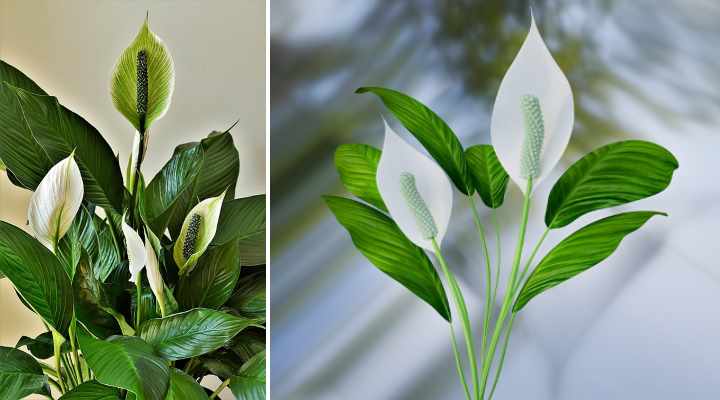
To properly care for Spathiphyllum, it should be grown in bright but filtered light, avoiding direct sunlight. This plant requires adequate light to produce its beautiful flowers, and shaded conditions may hinder its blooming, despite being a low-light plant.
If grown in low natural light, artificial light can be used to promote its growth and blooming. Spathiphyllum’s glossy foliage makes it a great tropical indoor plant for various rooms. However, too much direct sunlight can cause the leaves to turn yellow and develop brown spots, while yellowing leaves can indicate a severe lack of light.
Best Soil for Spathiphyllum Plants
To grow Spathiphyllum successfully in a pot, use a well-draining peat-based or cactus potting mix. The ideal soil should retain moisture while allowing excess water to drain out. A combination of peat moss, loam, and perlite is recommended for growing healthy Spathiphyllum plants in containers. Another option is to use organic-rich houseplant potting soil with added perlite, bark chips, or coarse horticultural sand to improve drainage.
When the Spathiphyllum roots sit in waterlogged soil, it can be detrimental to their health. The pot may be retaining too much water due to various reasons, such as being rootbound, the soil being too compacted, or the drainage hole at the bottom of the pot being clogged. It is important to ensure proper drainage to prevent overwatering and promote healthy growth.
How to Water Spathiphyllum

To care for your Spathiphyllum plant, water it when the top layer of soil has dried out. Make sure to thoroughly irrigate the potting soil by pouring in enough room-temperature filtered water or rainwater until it exits the drainage apertures. Afterward, allow the water to drain away before placing the plant in a bright area.
The frequency of watering your Spathiphyllum depends on various factors. During the growing season and hot weather, water your Spathiphyllum at least once or twice a week. However, in the winter when Spathiphyllum growth slows down, water less often, perhaps every two weeks or less. Remember to follow the rule of soil dryness when watering your Spathiphyllum plant. Keep in mind that Spathiphyllum is not drought-tolerant, so don’t let the soil dry out completely.
Frequent watering ensures that the roots of the Spathiphyllum are well-hydrated, allowing them to absorb nutrients and grow healthily. Don’t be afraid to drench the potting soil, as long as you allow it to dry somewhat between watering.
Temperature for Growing Spathiphyllum Indoors

Spathiphyllum plants grow best in indoor environments with temperatures ranging between 65°F and 85°F (18°C and 29°C). They prefer warm conditions since they are tropical houseplants. If the temperature drops below 55°F (12°C) or there are cold drafts, it can cause stress to the Spathiphyllum, so it’s important to avoid extreme temperature changes.
In USDA zones 10b and 11, Spathiphyllum plants can also grow outdoors. However, during the winter, temperatures below 65°F (18°C) can be harmful and may cause frost, which can kill the plant. If you want to grow Spathiphyllum plants as border plants in your backyard, make sure to place them in partial shade or dappled light. This will protect the plant from getting sunburned and from becoming too hot during the summer.
Spathiphyllum Humidity Requirements

To maintain proper humidity, regularly mist the leaves of the plant. Maintain the leaves with other plants or on a pebble tray to keep them moist. Regularly spray the leaves with water. To promote healthy development, maintain relative air moisture levels above 50%.
The easiest way to humidify Spathiphyllum is to regularly mist the leaves. Spray a fine mist around the foliage of your plants with a spray bottle filled with lukewarm distilled water. You may also moisten the glossy leaves by using a damp cloth to wipe them. This dust-cleaning action will not just hydrate the leaves; it will also clean them.
Spathiphyllum Growth Rate
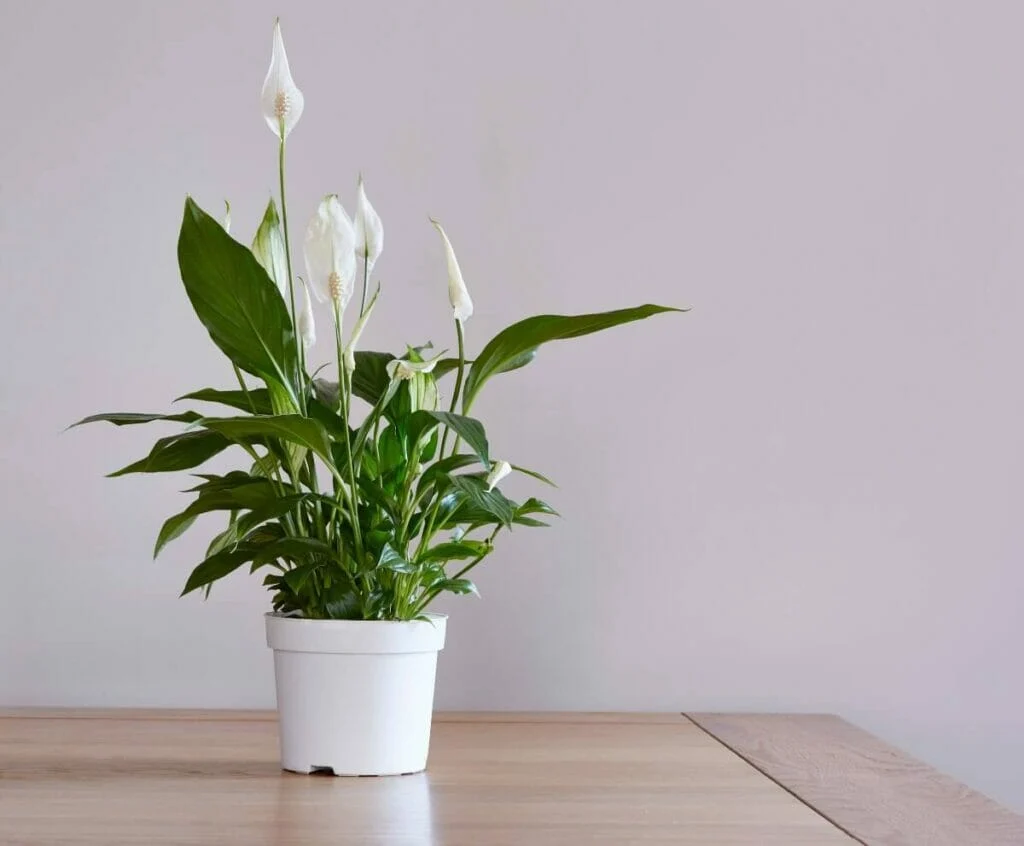
Under ideal conditions, Spathiphyllum plants can grow up to 18 to 24 inches (45 to 60 cm) tall at a normal pace. The growth of these plants is heavily influenced by the amount of light they receive. They thrive and grow faster when exposed to bright, indirect light. Conversely, their growth rate slows down significantly in dark rooms or in the shade.
Insufficient light can cause the leaves of Spathiphyllum plants to droop, and they may not produce any flowers. With the right amount of light, these plants can grow a few inches every year.
How to Fertilize Spathiphyllum Houseplants
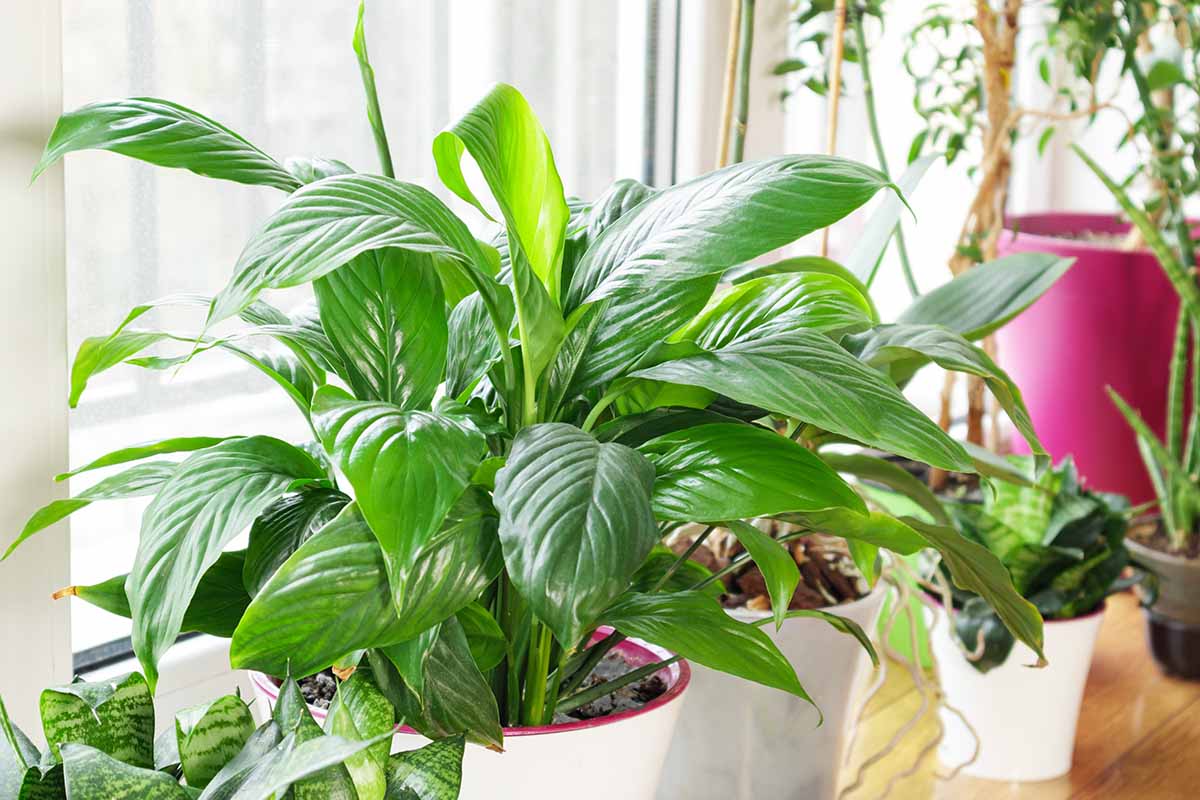
Throughout the spring and summer, apply fertilizer to Spathiphyllum plants every month. To provide the required nutrients, feed your plants with a balanced houseplant fertilizer. In order to ensure healthy development and consistent blooming, a water-soluble 10-10-10 fertilizer should be adequate. Late in the autumn and winter, don’t fertilize Spathiphyllum.
Throughout the growing season, regular fertilizing promotes Spathiphyllum growth. Root burn and poor development may be caused by a build-up of mineral salts in the potting medium. Flush the potting soil every two or three months after watering to prevent this issue.
All you have to do is run water over the soil for a few minutes to thoroughly soak it. Let the water run out while you wait. Wait until the top layer of soil has dried before watering again.
Spathiphyllum Pruning Guide

Spathiphyllum stems are typically located at the plant’s base and pruning is rarely necessary because of its natural bushy growth. However, if you need to reduce the size of the plant, you may need to trim it occasionally. Removing dead or dying leaves can also help to enhance the plant’s appearance.
After the Spathiphyllum has finished blooming, it is recommended to prune the stems. Each stem produces only one flower, and once the bloom fades, the stem turns brown and dies. Removing dead stems through pruning helps to redirect the plant’s energy towards growth and development.
Propagating Spathiphyllum
The best way to propagate a Spathiphyllum plant is through the root division. Remove the plant from its pot, shake the soil off of the roots, and cut the root ball into two or three pieces with a sharp clean knife to promote growth. Each root piece should have a few healthy stems and leaves.
The spring is the ideal season to start growing Spathiphyllum plants. A freshly-propagated plant may wilt after being repotted because Spathiphyllum is susceptible to fluctuations. The Spathiphyllum has a greater chance of survival when it propagates in the spring and grows vigorously.
Repotting Spathiphyllum (Peace Lily) Plants

When a Spathiphyllum plant outgrows its current pot, it’s time for repotting. Start by removing the plant from its pot and gently detangling and pruning any dead or brown roots. Next, fill the new pot with the appropriate potting mix and place the plant’s root ball in it.
If you want your Spathiphyllum to grow larger, transplant it to a bigger pot. On the other hand, if you wish to constrain its growth, trim about a third of its roots and repot it in a pot of similar size. But how do you know if your Spathiphyllum requires repotting due to being rootbound? Keep an eye out for the following signs:
- Roots are protruding through the drainage holes of the pot.
- Water takes longer to drain from the pot because the potting mix is dense and thick.
- Water is collecting on the soil surface because it can’t drain through.
- Growth slows down even during the growing season.
Is Spathiphyllum Toxic to Cats and Dogs?
Cats and dogs should not be ingested by Spathiphyllum plants. Spathiphyllum is said to include insoluble calcium oxalates, according to the ASPCA. Oral irritation, saliva, burning in the mouth, vomiting, and swallowing difficulties are all symptoms of this poisonous substance. Cats, dogs, and other pets should be kept away from your Spathiphyllum plants at home.
Is Spathiphyllum (Peace Lily) Toxic to Humans?
Humans should not consume any part of Spathiphyllum. According to researchers from North Carolina State Extension, the plant has medium severity features. Mouth burning and swollen lips are possible symptoms of Spathiphyllum. Contact with the plant has been linked to dermatitis in persons with sensitive skin, according to other studies.
Common Issues Growing Spathiphyllum Plants Indoors
What Pests Affect Spathiphyllum Growth?
Houseplant pests don’t seem to be a big problem for Spathiphyllum plants. Plant growth can be affected by spider mites, mealybugs, and aphids. To keep insects at bay, clean the leaves on a regular basis. When pests are present, use an insecticidal soap or a neem oil solution to get rid of them.
What Diseases Can Affect Spathiphyllum Plants?
Over-watering or insufficient drainage may lead to root rot in Spathiphyllum. Your houseplant may have diseased roots if you notice brown and wilting leaves. Repot the plant in fresh, sterile potting soil to help revive a dying Spathiphyllum. To help your plant recover, also eliminate all indications of dead or decaying roots.
Brown Tips on Spathiphyllum Leaves
Over-watering or under-watering are the most common reasons for brown tips on Spathiphyllum. Spathiphyllum leaves may turn brown as a result of a lack of humidity or build-up of fertilizer salts. Reduce watering or increase humidity if prune unappealing brown leaves.
Why Spathiphyllum Leaves are Drooping
Spathiphyllum leaves droop due to watering problems, whether too much or too little. What if the leaves of your Spathiphyllum are still drooping despite watering it correctly? All types of Spathiphyllum plants may wilt if there are chilly drafts or a rapid change in temperature.
Is Spathiphyllum an Air-Cleaning Houseplant?
Spathiphyllum cleans the air in your home by removing contaminants. Spathiphyllum may remove harmful airborne chemicals such as benzene, formaldehyde, and trichloroethylene, according to a NASA research on air-cleaning houseplants. Other air-filtering houseplants like English ivy, golden pothos, Dracaena “Warneckii,” and Sansevieria may aid to improve indoor air quality.
Varieties of Spathiphyllum
The following are some of the most commonly cultivated Spathiphyllum types:
Spathiphyllum wallisii (Peace lily)
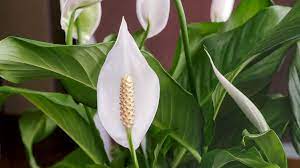
The most prevalent form of Spathiphyllum wallisii is the Wallisii variety. Madonna lily, spathe flower, and white sails are all common names for this popular houseplant. It has creamy-white flowers on a long stem. As the plant develops, the spathe becomes pale green.
Spathiphyllum cochlearispathum (Cupido peace lily)
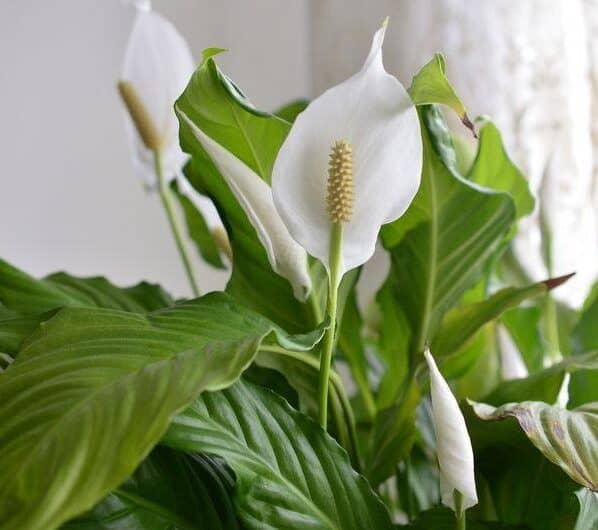
Peace lily is another name for the same species, Spathiphyllum cochlearispathum. The evergreen foliage plant produces brilliant white blooms that bloom continuously throughout the year and have broad, glossy green leaves.
Spathiphyllum floribundum (Snowflower)

Based on images, the Spathiphyllum floribundum displays a large lime-green to yellowish-green spathe. The flowers bloom on a thick, fleshy creamy white spadix.
Spathiphyllum montanum

The Spathiphyllum montanum is another kind of peace lily. This houseplant can be identified by the dark green lustrous leaves, which contrast with a pure white spathe.
Spathiphyllum ortgiesii Regel

The Spathiphyllum ortgiesii is native to Mexico, and its spathe is more oval-shaped than those of other species of Spathiphyllum flowers.
Spathiphyllum silvicola

Spathiphyllum silvicola is native to Colombia and Costa Rica. Its flowers are similar to those of other Spathiphyllum species, with a white-green spathe and yellowish spadix.
